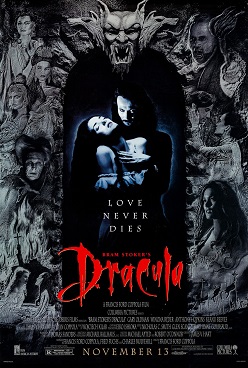Dracula’s greatest hunts
The five best versions of Dracula on-screen
Francis Ford Coppola’s Bram Stoker’s Dracula turned 30 this November, and what better way to celebrate than by revisiting some of the character’s best moments?
5. Dracula 2000 (2000)
Riding the leather-clad wave that Blade created, Gerard Butler’s Dracula shoots out of the shadows in a Matrix-esque black trench coat and combat boots. The soundtrack features some of the most iconic nu-metal bands of the time like Disturbed, System of a Down and Linkin Park, and some of the needle drops will give you whiplash.
The film departs from the source material, with a controversial twist. The daughter of vampire hunter Van Helsing (Justine Waddell) is hunted by Dracula (Gerard Butler) and must defeat him with the help of her father’s assistant, Simon (Jonny Lee Miller).
Produced by horror legend Wes Craven, Patrick Lussier’s Dracula 2000 gets way more hate than it should. It’s definitely longer than necessary and its titular character deserves more screen time, but overall it’s bloody campy fun.
4. Nosferatu (1922)
Murnau’s Nosferatu is a horror classic and a must-see for anyone with a passion for film. The film is an unauthorized adaptation of Stoker’s Dracula, and thus the famous Count’s name was changed to Count Orlok in the film.
In Murnau’s version of the story, real estate agent Hutter (Gustav von Wangenheim) travels to Transylvania to help Count Orlok (Max Schreck) purchase a house near Hutter’s home. During his visit, Orlok develops an interest in Hutter’s wife, Ellen (Greta Schröder). Hutter returns home and the vampiric Orlok soon follows, bringing a terrible plague with him.
Schreck’s performance as Orlok carries Nosferatu, and the film drags whenever he’s not on screen. Murnau uses shadows to create terrifically disturbing scenes; a particularly memorable one is when Orlok, with his gnarly long nails and intimidating stature, first enters Hutter’s room through the hallway in his castle. The film also features some impressive early special effects, like when a coffin lifts itself into a cart or when a sailor’s hallucination fades from view.
As an important piece of history, this is a must-watch, but it’s not quite as terrifying as it might have been 100 years ago.
3. Dracula (1958)
Terrence Fisher’s Dracula was the first of his series of films starring Christopher Lee as Dracula. Fisher focuses on the relationship between vampire hunter Van Helsing and Dracula in this interpretation and makes pretty significant changes to the original story. In Fisher’s version, Jonathan Harker (John Van Eyssen) is a vampire hunter who accepts work at Dracula’s castle with the intent to kill him. When things go awry, Van Helsing (Peter Cushing) has to hunt down Dracula while also protecting Harker’s family and friends.
Despite the focus on character building, there are still some genuinely spooky moments that manage to hold up in this film. The first reveal of Lee’s monstrous Dracula is awe-inspiring, with his eyes bloodshot and teeth dripping bright red. His snarl and stature make him quite terrible. Lee’s Dracula is extremely menacing, with his 6’4” stature and quiet power.
The choice to focus on Van Helsing and Dracula’s relationship is a unique one, and it pays off. Van Helsing and Dracula’s final clash in Dracula’s castle is intense, with Peter Cushing launching himself at Lee without concern and some face-melting special effects in its final moments.
2. Dracula (1931)
In 1931’s Dracula, Dracula (Bela Lugosi) moves to London, where he begins feeding. He sets his sights on Mina Seward (Helen Chandler), the fiancée of Jonathan Harker (David Manners), and becomes the object of family-friend Van Helsing’s (Edward Van Sloan) suspicion.
Bela Lugosi owns the character of Dracula. No matter how you feel about the film itself, it is undeniable that he was born to play this role. Dwight Frye’s performance as Dracula’s devoted follower Renfield is also compelling. His dark eyes and hysterical cries cut through the silence of the film and provide a nice contrast to the unnerving calm of Lugosi’s Dracula.
The atmosphere in this film is unmatched. The castle in this film is the best of these five. It’s filled with massive cobwebs and crumbling stone pillars, a completely desolate gothic dream. The long stretches of white noise due to a lack of score make some of the scarier moments even more unnerving, and Lugosi’s powerful presence can be felt through the screen.
1. Bram Stoker’s Dracula (1992)
Coppola’s Dracula is one of the more critically acclaimed interpretations to come out in the last 30 years. It was nominated for four Academy Awards, three of which it won. Eiko Ishioka’s Oscar-winning costumes are mind-blowing, and the film is worth the watch for the stunning costumes and makeup alone.
On a purely aesthetic level, this and 1931’s are definitely favorites. Despite the visuals being so different, both really nail the atmosphere and characters from Stoker’s novel. Nearly everything was done with practical effects and film cameras, yet it still holds up.
The star-studded cast features fabulous performances by Gary Oldman, Winona Ryder and Anthony Hopkins, as well as a more infamous version of protagonist Jonathan Harker played by Keanu Reeves. This adaptation is one of the most faithful to the novel as well, which accounts for its lengthiness.
Ultimately, the combination of beautiful costumes, stellar performances and accuracy is what sets this film apart from the rest.
If you are interested, definitely check some of these films out. Nosferatu is in the public domain and available for free on YouTube, while the rest can be found on streaming services.
Tags: Movie Review vampire Dracula
Josey Merolli. Hey, I'm Josey (she/her) and I'm entertainment editor! More »
Comments
Please ensure that all comments are mature and responsible; they will go through moderation.
